
#bikeuptown: Protected bike lanes for Uptown Waterloo
Uptown Waterloo can be a place that’s great for anyone to bike.
Find out how you can help make it happen.

Uptown Waterloo can be a place that’s great for anyone to bike.
Find out how you can help make it happen.
On Monday, City of Waterloo Council will be receiving a report from Professor Casello and Professor Moos of the University of Waterloo concerning the economic contributions of bicycle users to Uptown.
Key findings include:
This study contributes to the already compelling case for protected bike lanes on King Street. A street that is safe and welcoming to all modes of travel would boost the economic vitality of the Uptown core.
For more details, see the full report below.
(more…)
Today, protesters attempted to halt paving work on the Hillside Trail in Waterloo. The action and the rhetoric surrounding it would have you believe that the trail and park are facing some sort of existential threat, and the instigators’ narrative of having their park “destroyed” without consultation has become the dominant one in the media.
TriTAG has put up a vigorous defence in the past when it felt that a trail was under threat, but in this case, we are perplexed by the actions and words of some residents. When we spoke up in defence of the Iron Horse Trail, we were concerned that the safety and experience of the trail by all users was being degraded to satisfy private interests. In the case of the Hillside Trail however, it seems that a small group is trying to oppose improvements that would make the trail more accessible to everyone. (more…)
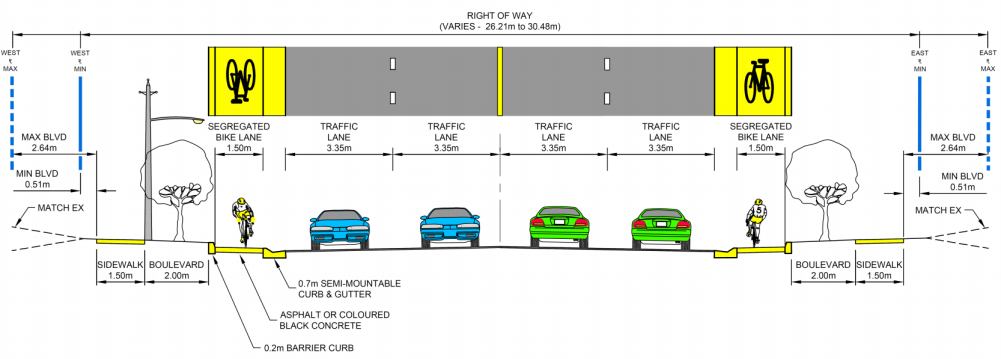
TriTAG is concerned by apparently disingenuous tactics being used in an attempt to derail plans for Waterloo Region’s first segregated bike lanes on Manitou Drive.
In August, the Regional Planning and Works Committee unanimously approved the preferred design option for the Manitou Drive improvements, which would include sidewalks and segregated bike lanes on both sides of the road. The segregated bike lanes would provide continuity between planned bike lanes to the north on Manitou Drive between Bleams and Fairway, and with bike lanes to the south on Doon Village Road. They would also help to form an on-road cycling route between the Doon Village neighbourhood, the Trans-Canada Trail, and ION rapid transit. Presently absent sidewalks would provide safe walking space and would be essential to expanding transit service to the area. Final approval of plans for Manitou Drive is scheduled for the Regional Council meeting on September 17, 2014.
Flyers have recently appeared in the Doon Village neighbourhood, claiming that the committee-approved bike lanes would be “very dangerous” and “cause fatalities.” As an alternative, they propose no sidewalks and one multi-use trail on the east side of the road, to be shared by both pedestrians and cyclists. These flyers, which call on residents to contact Regional Council members, contain several errors and exaggerations, as we will outline below. (more…)
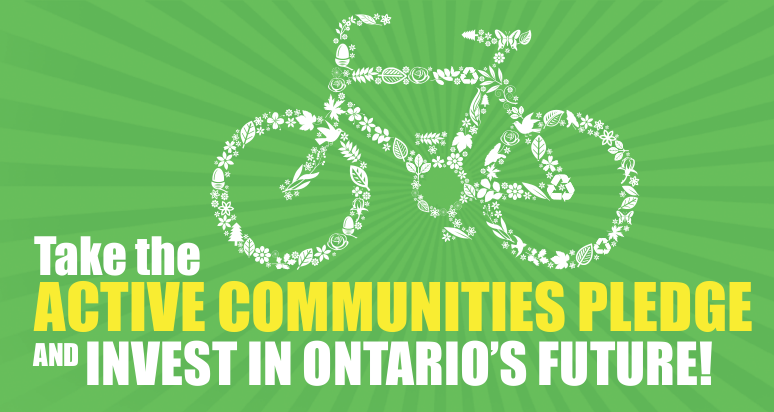
For Immediate Release
Campaign invites municipal candidates to endorse cycling and active transportation
before Waterloo Region residents go to the polls on October 27th
WATERLOO REGION – September 2, 2014. Twenty-four municipal candidates from Cambridge, Kitchener, and Waterloo have pledged to support walking and biking in their communities if elected, more than all other Ontario municipalities combined. In the wake of recent opinion polls that show growing support for measures to promote cycling, this Ontario-wide campaign is asking candidates in the upcoming October 27th municipal election to back policies that support cycling and other forms of active transportation.
In addition to having the most council and mayoral candidates supporting the pledge, the Region also boasts the first two school board trustee candidates to support safer walking and cycling to school. (more…)
Hopefully, by now you’ve had a chance to see the new proposal for Uptown Waterloo’s new streetscape, and how King St. could be reshaped all the way from Erb up to University. If you haven’t, go ahead and take a look at the public information boards presented last Thursday. You can also read more about the project’s evolution here.
This proposal needs your support. Please provide your feedback on the Uptown Streetscape project by email to Barb Magee Turner (barb.mageeturner@waterloo.ca) and Eric Saunderson (esaunderson@regionofwaterloo.ca) by Thursday June 12th! Tell them what you like about it, how you see yourself using it, and any suggestions for further improvement. NEW: Write to the project managers and members of council with our easy contact form.
Not sold on protected bike lanes yet? Check out our infographic. Or, read on for more details on why this is the right fit for uptown.
TriTAG believes the new proposal is a vast improvement over the November 2013 plan. Whereas the old plan was presenting awkward and potentially dangerous cycling infrastructure, the protected bike lane solution for Uptown isn’t just good for cyclists, but for everyone.
The presence of protected bicycle lanes will help to attract people to uptown by bike, including many who do not cycle now, some who do bike but avoid King St, as well as the influx of thousands of new residents coming to the intensifying King St. corridor. This increase of cycling is the experience of cities like Montreal, Chicago, Philadelphia, New York and Washington DC and was the subject of a recent study that found that protected bike lanes led to ridership growth of 21 to 171 per cent. Furthermore, this trend also appears to be a boost to business along the route.
Add to all this new data showing that protected bike lanes and their intersections don’t just feel safe, they’re also very safe in practice.
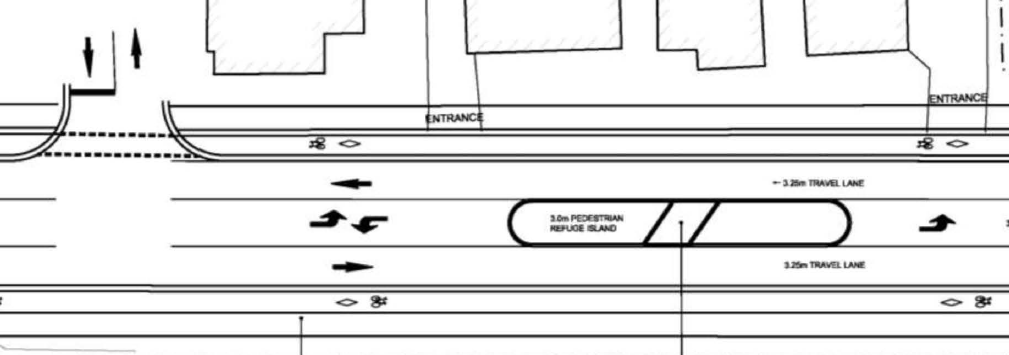
King St. North will serve everyone better with protected bike lanes, pedestrian islands and turn lanes.
But ultimately, every customer of a King St. business arrives on foot whether they travel by car, bike or transit. The new proposal shines here, too. Space will allow for both wider, more welcoming sidewalks, and increased ability for pedestrians to cross King St. by slowing traffic, introducing crossing islands, and reducing crossing distances. Meanwhile, the protected bicycle lanes will get cyclists off the sidewalks and provide an extra buffer from traffic that will make the pedestrian realm even more comfortable.
It’s unfortunate that for a few, none of this matters as much as the removal of 22 on-street parking spaces. But as we have pointed out before, this is a tiny fraction– less than 1%– of the Uptown parking supply. Furthermore, these lost spaces will be more than replaced by a new planned parking lot, with the opportunity to adjust to parking demands along side streets and with new development.
Space along King St. is precious, and we should be using it to its maximum effect. A small reduction in space for car storage gives us the chance to build an Uptown that is human-friendly, designed to safely move all road users, and truly welcoming. TriTAG believes this is a trade worth making, and we hope you agree.
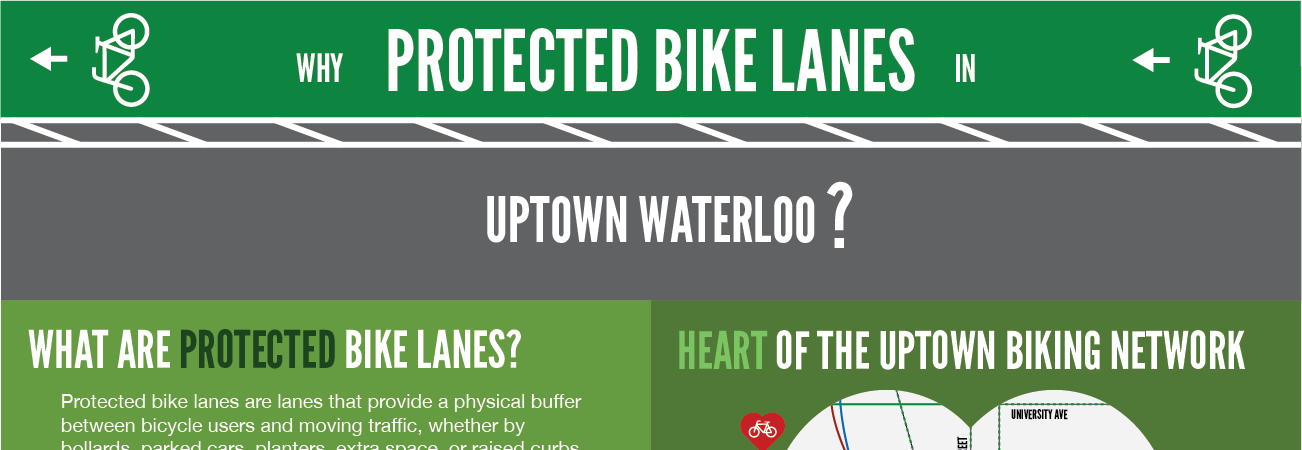
King Street in Uptown Waterloo is being redesigned, and due to popular demand, protected bike lanes are now being considered as an option for the blocks between Erb and Central.
TriTAG is supportive of protected bike infrastructure because it can make bicycling an attractive choice to most people. This is a once in a generation opportunity to make Uptown a truly walkable and bikable place. But businesses have concerns about changes to the Uptown streetscape, so we’ve created an infographic to help understand the benefits and trade-offs of protected lanes. (more…)

Check out this great one page summary on the benefits of protected bike lanes. It speaks for itself.
(Hat tip to Transitized for the great infographic!)
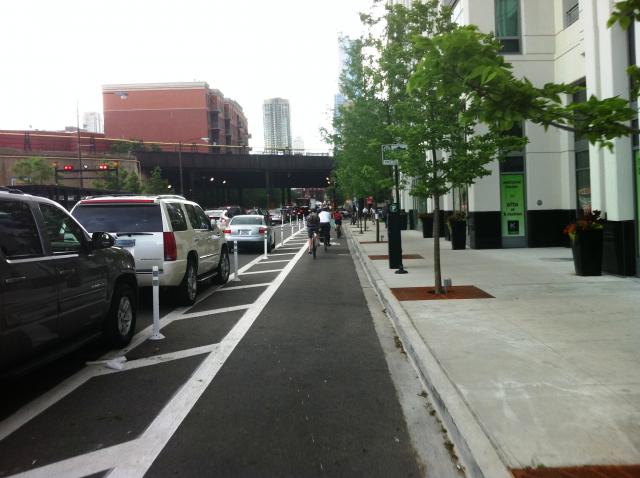

Uptown streetscape: lots of room for improvement. (image courtesy City of Waterloo)
Do you bike through Uptown Waterloo? What if you could ride along King Street protected from traffic by a curb and parked cars?
In a few years, King Street’s pedestrian-hostile four lane thoroughfare will be a thing of the past between downtown Kitchener and Waterloo Town Square. Implementing ION will mean removing two of those lanes.
In light of this, the city of Waterloo (in partnership with the region) wants to improve King from Erb St. all the way up to University Avenue. Their plan: trim the redundant road lanes that would dead end in Uptown, and use the room to provide better access for people on foot or bike. The goal: create a friendlier, safer Uptown with space for people to move around, shop, and enjoy the scenery, while smoothing traffic flow along King. As part of this plan, the city proposes to paint traditional bike lanes of sub-standard width in between rows of parking and road lanes heavy with cars and buses.
We think they could do a lot better: instead of sandwiching cyclists between open car doors and moving traffic, why not use those parked cars to protect people on bikes? King Street may be the perfect location for Waterloo to implement its very first protected bike lanes.
Protected bike lanes are paths for bikes along roads but separated from traffic by a curb, parked cars, or other barriers like planters. With as many as 60% of people interested in cycling but concerned about safety, protected bike lanes are cycling infrastructure for the rest of us. And their popularity has exploded, in places like New York, Toronto, Vancouver, Ottawa, and Montreal. Even Guelph has installed curb-protected bike lanes on part of Stone Road: providing a friendly space for bikes has greatly reduced the amount of people riding their bikes on the sidewalk.
Protected bike lanes are effective because they feel much safer for casual riders and their families. How safe are they really? One study took a look at protected bike lanes in Montreal, and found that they substantially reduce injuries while attracting riders from less bike-friendly roads. The University of British Columbia has shown that on top of being preferable, protected bike lanes get top marks for safety.
But what’s in it for Uptown? Business owners and merchants, who customarily focus on more parking to bring in customers, could stand to reap huge dividends from the presence of friendly bike infrastructure. A study of Bloor West in Toronto found that pedestrians and cyclists visit local businesses the most often and spend more money than motorists. New York created the United States’ first protected bike lanes on 9th Avenue and consequently, businesses there saw a 49% increase in retail sales. Closer to home, Waterloo’s ongoing intensification means that number of potential customers within walking and cycling distances of Uptown is growing rapidly.
Protected bike lanes are coming eventually: evidence keeps building on the benefit they can provide to our urban environment, and they’re starting to attract Waterloo’s attention. Councillor Melissa Durrell has said that she would like to see protected bike lanes and we agree with her.
This is where you come in. A good idea needs support! Visit the public consultation (and submit your feedback), and write your councillors. Tell them Waterloo needs protected bike lanes. To make cycling accessible and safe for everyone, and to keep our Uptown vibrant and healthy, we need to be heard: It’s time for protected bike lanes in Waterloo.

As many readers may be aware, Kitchener is proceeding with a plan to introduce sharrows to King Street in downtown Kitchener, along with new bike racks, public events, and other measures designed to make promote cycling and improve the understanding of sharing the road among cyclists and motorists.
TriTAG supports the proposals in the Cycling Facilities and Downtown Branding report – the City staff responsible should be commended with such forward-thinking initiatives and thorough analysis. We would like to speak in particular about the plan to add sharrows to King Street in downtown Kitchener, and the critical importance of measuring the effect of this improvement.
In 2010, TriTAG saw an opportunity to measure the effects of new cycling lanes and markers in the city of Guelph. Over the next two years, we were able to gather evidence that showed: More citizens chose to cycle, and fewer rode on the sidewalk. This report has been of great use to the City of Guelph – all from a few volunteers taking time off of work to sit in brisk early morning temperatures at the side of the road with clipboards. If we’d had the right resources to allocate to further study, we would have been able to accomplish even more.
The “Kitchener Cycling Branding and Downtown Cycling Facilities” report draws from the experience of cities like San Francisco, Miami Beach, Seattle, and Cambridge, Massachusetts. Experience there suggests that sharrows can work well where space is at a premium and traffic speed is low – but we lack study of local examples. In light of this, Kitchener staff, in collaboration with TriTAG and the Kitchener Cycling Advisory Committee, have developed a plan to measure the effect of sharrows in the downtown. We commend council’s support of the study – to assign a few hours of staff and volunteer time to measure the impact of this modest but important investment – because we believe that the sharrows approved for King Street can have a big impact – and that the city should have the proof to back up the success of their initiative.
Why stop here? We would love to see Kitchener take a more rigorous approach to measuring cycling traffic. Plans to gauge the effect of new cycling infrastructure over time ought to be routine. Our city needs to understand cause and effect if we’re going to live up to the cycling master plan’s vision of doubling cycling trips every three to five years. Learning what works is important – without measuring, we cannot truly say what works and what doesn’t.
As this report shows, we can learn from the experiences of other cities; with the addition of better measurement on our part, not only can we learn from our own experiences as well, but we can provide Kitchener’s hard data approach to measurement as a gold standard when other communities come calling to ask how we built a more efficient and complete cycling network.